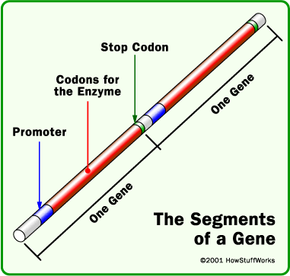The Big Question
You may remember from a previous section that enzymes are formed from 20 different amino acids strung together in a specific order. Therefore the question is this: How do you get from DNA, made up of only four nucleotides, to an enzyme containing 20 different amino acids? There are two answers to this question:
- An extremely complex and amazing enzyme called a ribosome reads messenger RNA, produced from the DNA, and converts it into amino-acid chains.
- To pick the right amino acids, a ribosome takes the nucleotides in sets of three to encode for the 20 amino acids.
What this means is that every three base pairs in the DNA chain encodes for one amino acid in an enzyme. Three nucleotides in a row on a DNA strand is therefore referred to as a codon. Because DNA consists of four different bases, and because there are three bases in a codon, and because 4 * 4 * 4 = 64, there are 64 possible patterns for a codon. Since there are only 20 possible amino acids, this means that there is some redundancy -- several different codons can encode for the same amino acid. In addition, there is a stop codon that marks the end of a gene. So in a DNA strand, there is a set of 100 to 1,000 codons (300 to 3,000 bases) that specify the amino acids to form a specific enzyme, and then a stop codon to mark the end of the chain. At the beginning of the chain is a section of bases that is called a promoter. A gene, therefore, consists of a promoter, a set of codons for the amino acids in a specific enzyme, and a stop codon. That is all that a gene is.
Advertisement
To create an enzyme, the cell must first transcribe the gene in the DNA into messenger RNA. The transcription is performed by an enzyme called RNA polymerase. RNA polymerase binds to the DNA strand at the promoter, unlinks the two strands of DNA and then makes a complementary copy of one of the DNA strands into an RNA strand. RNA, or ribonucleic acid, is very similar to DNA except that it is happy to live in a single-stranded state (as opposed to DNA's desire to form complementary double-stranded helixes). So the job of RNA polymerase is to make a copy of the gene in DNA into a single strand of messenger RNA (mRNA).
The strand of messenger RNA then floats over to a ribosome, possibly the most amazing enzyme in nature. A ribosome looks at the first codon in a messenger RNA strand, finds the right amino acid for that codon, holds it, then looks at the next codon, finds its correct amino acid, stitches it to the first amino acid, then finds the third codon, and so on. The ribosome, in other words, reads the codons, converts them to amino acids and stitches the amino acids together to form a long chain. When it gets to the last codon -- the stop codon -- the ribosome releases the chain. The long chain of amino acids is, of course, an enzyme. It folds into its characteristic shape, floats free and begins performing whatever reaction that enzyme performs.
